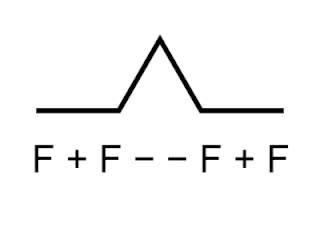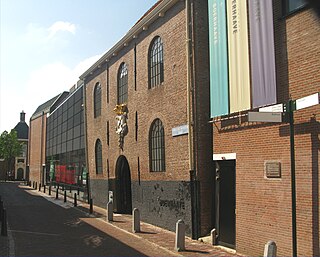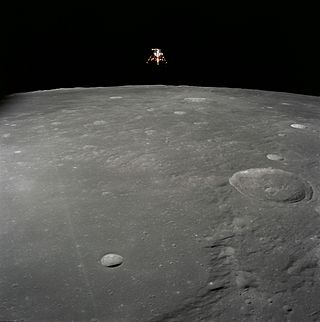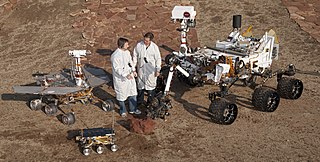
Logo is an educational programming language, designed in 1967 by Wally Feurzeig, Seymour Papert, and Cynthia Solomon. Logo is not an acronym: the name was coined by Feurzeig while he was at Bolt, Beranek and Newman, and derives from the Greek logos, meaning word or thought.

A plotter is a machine that produces vector graphics drawings. Plotters draw lines on paper using a pen, or in some applications, use a knife to cut a material like vinyl or leather. In the latter case, they are sometimes known as a cutting plotter.
robots.txt is a standard used by websites to indicate to visiting web crawlers and other web robots which portions of the website they are allowed to visit.
Computer art is any art in which computers play a role in production or display of the artwork. Such art can be an image, sound, animation, video, CD-ROM, DVD-ROM, video game, website, algorithm, performance or gallery installation. Many traditional disciplines are now integrating digital technologies and, as a result, the lines between traditional works of art and new media works created using computers has been blurred. For instance, an artist may combine traditional painting with algorithm art and other digital techniques. As a result, defining computer art by its end product can thus be difficult. Computer art is bound to change over time since changes in technology and software directly affect what is possible.

Alexander Emerick Jones is an American far-right and alt-right radio show host and prominent conspiracy theorist. He hosts The Alex Jones Show from Austin, Texas, which the Genesis Communications Network broadcasts across the United States. Jones's website, InfoWars, promotes conspiracy theories and fake news, as do his other websites NewsWars and PrisonPlanet. Jones has provided a platform and support for white nationalists, giving Unite the Right rally attendee and white supremacist Nick Fuentes a platform on his website Banned.Video, as well as serving as a potential "entry point" to their ideology.

I, Robot is a 2004 American science fiction action film directed by Alex Proyas. The screenplay by Jeff Vintar and Akiva Goldsman is from a screen story by Vintar, based on his original screenplay Hardwired, and named after Isaac Asimov's 1950 short-story collection. The film stars Will Smith in the main role, Bridget Moynahan, Bruce Greenwood, James Cromwell, Chi McBride, and Alan Tudyk. In 2035, highly intelligent robots fill public service positions throughout the dystopian world, operating under three rules to keep humans safe. Detective Del Spooner (Smith) investigates the alleged suicide of U.S. Robotics founder Alfred Lanning (Cromwell) and believes that a human-like robot called Sonny (Tudyk) murdered him.

The inker is one of the two line artists in traditional comic book production.

Saturn 3 is a 1980 British science fiction film produced and directed by Stanley Donen, and starring Farrah Fawcett, Kirk Douglas and Harvey Keitel. The screenplay was written by Martin Amis, from a story by John Barry. Though a British production, the film has an American cast and director.

Samson & Goliath, also known as Young Samson, is an American animated television series produced by Hanna-Barbera Productions for NBC, where it debuted on September 9, 1967. Primarily sponsored by General Mills, who controlled the distribution rights through its agency Dancer Fitzgerald Sample, Samson & Goliath was retitled Young Samson in April 1968 to avoid confusion with the stop-motion Christian television series Davey and Goliath.

Rijksmuseum Boerhaave is a museum of the history of science and medicine, based in Leiden, Netherlands. The museum hosts a collection of historical scientific instruments from all disciplines, but mainly from medicine, physics, and astronomy.

Polar fleece is a soft napped insulating fabric made from polyester.

The physical exploration of the Moon began when Luna 2, a space probe launched by the Soviet Union, made an impact on the surface of the Moon on September 14, 1959. Prior to that the only available means of exploration had been observation from Earth. The invention of the optical telescope brought about the first leap in the quality of lunar observations. Galileo Galilei is generally credited as the first person to use a telescope for astronomical purposes; having made his own telescope in 1609, the mountains and craters on the lunar surface were among his first observations using it.

A rover is a planetary surface exploration device designed to move across the solid surface on a planet or other planetary mass celestial bodies. Some rovers have been designed as land vehicles to transport members of a human spaceflight crew; others have been partially or fully autonomous robots. Rovers are typically created to land on another planet via a lander-style spacecraft, tasked to collect information about the terrain, and to take crust samples such as dust, soil, rocks, and even liquids. They are essential tools in space exploration.

Astrobotic Technology is an American privately held company that is developing space robotics technology for lunar and planetary missions. It was founded in 2007 by Carnegie Mellon professor Red Whittaker and his associates with the goal of winning the Google Lunar X Prize. The company is based in Pittsburgh, Pennsylvania. The first launch of one of its spacecraft, the Peregrine lunar lander, is expected to take place in the first quarter of 2023.

The Lunar Reconnaissance Orbiter (LRO) is a NASA robotic spacecraft currently orbiting the Moon in an eccentric polar mapping orbit. Data collected by LRO have been described as essential for planning NASA's future human and robotic missions to the Moon. Its detailed mapping program is identifying safe landing sites, locating potential resources on the Moon, characterizing the radiation environment, and demonstrating new technologies.
DAC-1, for Design Augmented by Computer, was one of the earliest graphical computer aided design systems. Developed by General Motors, IBM was brought in as a partner in 1960 and the two developed the system and released it to production in 1963. It was publicly unveiled at the Fall Joint Computer Conference in Detroit 1964. GM used the DAC system, continually modified, into the 1970s when it was succeeded by CADANCE.

A lunar rover or Moon rover is a space exploration vehicle designed to move across the surface of the Moon. The Apollo Program's Lunar Roving Vehicle was driven on the Moon by members of three American crews, Apollo 15, 16, and 17. Other rovers have been partially or fully autonomous robots, such as the Soviet Union's Lunokhods and the Chinese Yutus. Three countries have had operating rovers on the Moon: the Soviet Union, the United States and China. An Indian mission failed while Japan and Greece currently have planned missions.
The Sandy Hook Elementary School shooting occurred on December 14, 2012, in Newtown, Connecticut. The perpetrator, Adam Lanza, fatally shot his mother before murdering 20 students and six staff members at Sandy Hook Elementary School, and later committed suicide. A number of fringe figures have promoted conspiracy theories that doubt or dispute what occurred at Sandy Hook. Various conspiracy theorists have claimed, for example, that the massacre was actually orchestrated by the U.S. government as part of an elaborate plot to promote stricter gun control laws.

Ex Machina is a 2014 science fiction film written and directed by Alex Garland in his directorial debut. There are four significant characters, played by Domhnall Gleeson, Alicia Vikander, Sonoya Mizuno, and Oscar Isaac. In the film, programmer Caleb Smith (Gleeson) is invited by his CEO (Isaac) to administer the Turing test to an intelligent humanoid robot (Vikander).

Kubo and the Two Strings is a 2016 American stop-motion animated action fantasy film produced by Laika. It is directed by Travis Knight with a screenplay by Marc Haimes and Chris Butler from a story by Shannon Tindle and Marc Haimes, and it stars the voice roles of Charlize Theron, Art Parkinson, Ralph Fiennes, George Takei, Cary-Hiroyuki Tagawa, Brenda Vaccaro, Rooney Mara, and Matthew McConaughey. The film revolves around Kubo, a young boy who wields a magical shamisen and whose left eye was stolen during infancy. Accompanied by an anthropomorphic snow monkey and beetle, he must embark on a quest to defeat his mother's evil twin Sisters and his power-hungry grandfather, the Moon King, who is responsible for stealing his left eye.















